Country United States Period 1958 Number of tests 3 | Test type space rocket (> 80 km) Start date September 1958 | |
 | ||
Max. yield 1.5 kilotonnes of TNT (6.3 TJ) | ||
Operation argus 1958 atmospheric nuclear tests
Operation Argus was a series of United States nuclear weapons tests and missile tests secretly conducted during August and September 1958 over the South Atlantic Ocean. They were performed by the Defense Nuclear Agency, in conjunction with the Explorer 4 space mission. Operation Argus was conducted between the nuclear test series Operation Hardtack I and Operation Hardtack II. Contractors from Lockheed Aircraft Corporation as well as a few personnel and contractors from the U.S. Atomic Energy Commission were on hand as well.
Contents
- Operation argus 1958 atmospheric nuclear tests
- Objectives
- Task Force 88
- The satellites
- Tests
- List of ships involved in Operation Argus
- References

Objectives
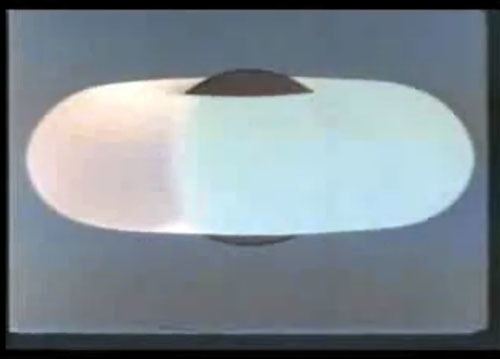
The tests were proposed by Nicholas Christofilos of what was then the Livermore branch of the Lawrence Radiation Laboratory (now Lawrence Livermore National Laboratory) as a means to verify the Christofilos effect, which argued that high-altitude nuclear detonations would create a radiation belt in the extreme upper regions of the Earth's atmosphere. Such belts would be similar in effect to the Van Allen radiation belts. Such radiation belts were viewed as having possible tactical use in war. Prior to Argus, Hardtack Teak had shown disruption of radio communications from a nuclear blast, though this was not due to the creation of radiation belts.

Argus was implemented rapidly after inception due to forthcoming bans on atmospheric and exoatmospheric testing. Consequently, the tests were conducted within a mere half year of conception (whereas "normal" testing took one to two years).
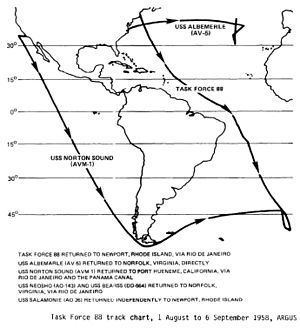
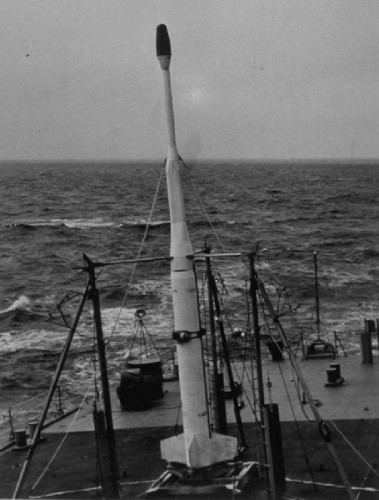
Originally Argus was designated Hardtack-Argus, and later Floral. For reasons of security, both names were dropped in favor of the independent name Argus.
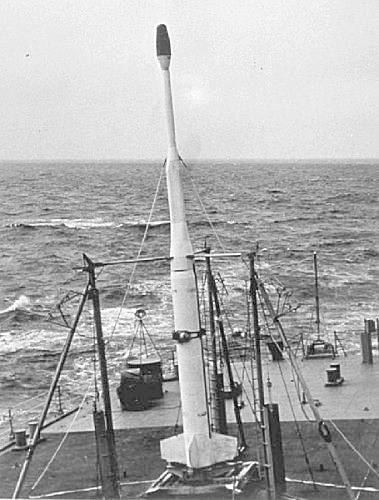
Funding was provided by the Armed Forces Special Weapons Project (AFSWP), the predecessor of today's Defense Threat Reduction Agency (DTRA). Total funds allotted for the project were US$ 9,023,000.
Task Force 88
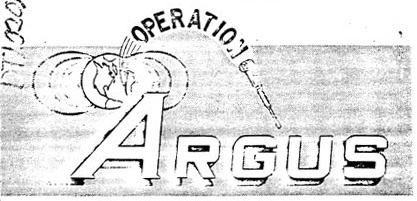
The United States Navy Task Force 88 (or TF-88), was formed April 28, 1958. TF-88 was organized solely to conduct Operation Argus. Once Argus was completed, the task force was dissolved, and its records dispersed. Some of these records have been destroyed or lost in the intervening time period. Of particular note among the missing documents were the film records (which recorded radiation levels during the Argus tests). This has proved contentious due to the higher-than-normal number of leukemia claims among TF-88 participants to the Veterans Administration. Because of this, it has been difficult to resolve just how much radiation participants were exposed to.

USS Norton Sound was responsible for missile-launching functions. She also served as a training facility for crews involved in the testing. The X-17A missiles to be used in the test were unfamiliar to those conducting the tests. Exercises including assembly and repair of dummy missiles were conducted aboard Norton Sound. She also carried a 27-MHz COZI radar, which was operated by Air Force Cambridge Research Center, which was used to monitor effects of the shots.
USS Albemarle, fresh out of an overhaul, was not listed on the TF-88 order. She set out to the Atlantic, supposedly on shakedown. She, too, mounted a COZI radar and other instrumentation for detecting man-made ionization.
USS Tarawa served as overall command of the operation, with her commander serving as Task Group Commander. She carried an Air Force MSQ-1A radar and communication system for missile tracking. She also housed VS-32 aircraft for search and security operations as well as scientific measurement, photographic, and observer missions for each shot. HS-5 was also aboard and provided intra-task-force transportation for personnel and cargo.
USS Warrington, in conjunction with Bearss, Hammerberg, and Courtney maintained a weather picket 463 km west of the task force, provided a plane guard for Tarawa during flight operations, and carried out standard destroyer functions (such as surface security and search and rescue). Warrington also carried equipment for launching Loki Dart rockets.
USS Neosho refueled task force ships during the operation. She was also outfitted with Air Force MSQ-1A radar. Her commanding officer also served as the flagship for TG 88.3, the Mobile Logistics Group, consisted of: Neosho, equipped with USAF MSQ-1 radar and communication vans, USS Salamonie (AO-26), and assigned destroyers.
USS Salamonie returned to the United States upon arrival at TF-88, and did not participate in any shots.
The satellites
Two satellite launches were attempted. Explorer 4 was successfully launched on July 26. Explorer 5 suffered a launch failure on August 24.
Tests
About 1800 km southwest of Cape Town, South Africa, USS Norton Sound launched three modified X-17A missiles armed with 1.7 kt W-25 nuclear warheads into the upper atmosphere, where high altitude nuclear explosions took place. Due to the South Atlantic Anomaly, the Van Allen radiation belt is closer to the Earth's surface at that location. The (extreme) altitude of the tests was chosen so as to prevent personnel involved in the test from being exposed to any ionizing radiation.
Coordinated measurement programs involving satellite, rocket, aircraft, and surface stations were employed by the services as well as other government agencies and various contractors worldwide.
The Argus explosions created artificial electron belts resulting from the β-decay of fission fragments. These lasted for several weeks. Such radiation belts affect radio and radar transmissions, damage or destroy arming and fusing mechanisms of intercontinental ballistic missile warheads, and endanger crews of orbiting space vehicles.
Argus proved the validity of Christofilos' theory: the establishment of an electron shell derived from neutron and β-decay of fission products and ionization of device materials in the upper atmosphere was demonstrated. It not only provided data on military considerations, but produced a "great mass" of geophysical data.
The tests were first reported by the New York Times on March 19, 1959, headlining it as the "greatest scientific experiment ever conducted." Approximately nine ships and 4,500 people participated in the operation. After the completion of testing, the task force returned to the United States via Rio de Janeiro, Brazil.
The tests were announced the following year, but the full results and documentation of the tests were not declassified until April 30, 1982.
